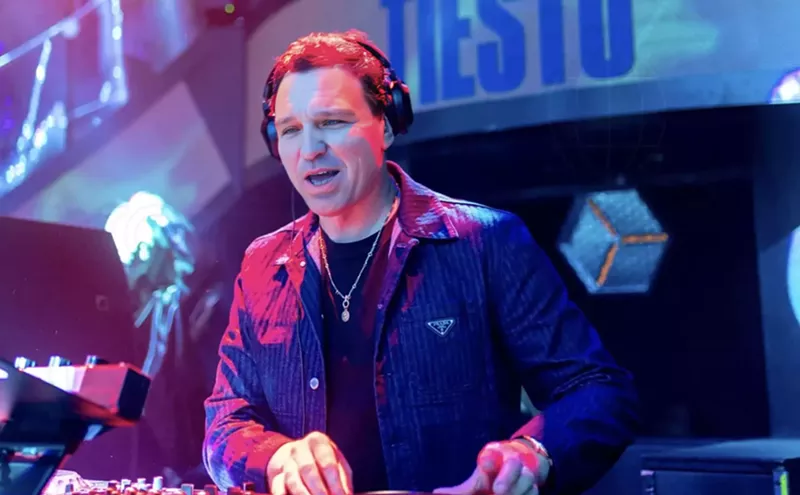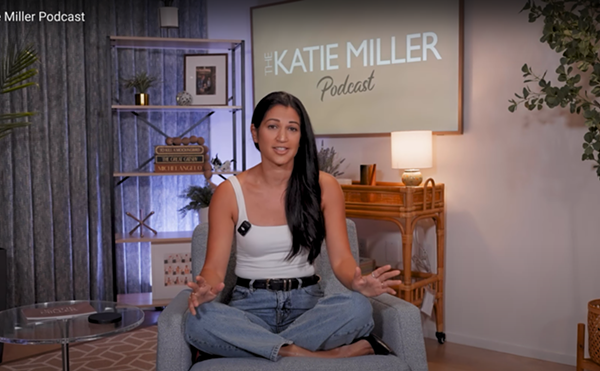I'm putting on an awesome display of ineptitude, running back and forth, flailing my racket at the birdie or bird or shuttlecock or whatever it is. My 53-year-old opponent, Dave Zarco, has a slight paunch and wears spectacles. He seems quite relaxed, returning every drop shot, drive, and lame excuse for a slam I send his way. Meanwhile my 30-year-old body has diverted all of its functions to sweat production, and the constant lunging motion involved with getting to Zarco's well-placed shots is wreaking havoc on my gluteal muscles.
Zarco is one of the organizers of the seventh annual Southern Pan Am International Badminton Tournament, which was held at Don Shula's Athletic Club in Miami Lakes last Thursday. He revels in revealing the game to the uninitiated. He especially likes beating the piss out of anyone foolhardy enough to call badminton a "puss game."
Call it what you want, but it's one of the fastest, most athletic, and most popular sports — seriously — in the world. In the United States, Miami and Los Angeles are the only two cities to host international play every year. Along with L.A., Chicago, and a handful of Midwestern metropolises, Miami is one of the few American cities to field high school varsity badminton teams; there are sixteen of them this year.
Coincidentally players from several of those teams battled it out for the county finals at G. Holmes Braddock Senior High School just two days before the Pan Am. The overall champion, Coral Gables Senior High School, won't be eligible for a state title, however, seeing as no other county in Florida has high school badminton. In fact Miami-Dade is the only county with high school badminton in the southeastern United States.
The game has its origins in similar sports that were played in ancient Greece, India, and China. The modern version began as poona in India and, along with chutney and curry, was adopted in the 1860s by British army officers stationed on the subcontinent. A well-attended game played on the grounds of Badminton estate in Gloucestershire, England, launched the sport in the Anglo world and gave it the moniker it bears today.
The International Badminton Federation, headquartered in Gloucestershire since 1934, recently moved to Kuala Lumpur, Malaysia, where rabid fans subscribe to daily online match updates and badminton news. When the 14-million member IBF holds an "Extra Ordinary General Meeting" or just an ordinary meeting — the most recent was in Beijing last May — more than 100 delegates show up from all over the world.
Although Asia is where it's at in the world of shuttlecocks, Denmark still trains some of the best players, and Latin America has made strides in recent years. Brazil is considered one of the sport's sleeping giants, and famed coaches such as Adrián "El Profesor" Gómez hail from Central America. Badminton became an official Olympic sport at Barcelona in 1992 and was televised for the first time at Athens in 2004. ESPN 2, bastion of billiards and bowling, occasionally broadcasts matches.
The sport made landfall in South Florida when a gentleman named Easter Smith founded the Greater Miami Badminton Association in the 1940s. Over the years, people such as Bill Graham — brother of former U.S. Sen. Bob Graham and the late Phil Graham, publisher of the Washington Post — fell in love with the sport and pushed for its inclusion in schools. Bill Graham, in attendance at the Pan Am, drummed up support for construction of the badminton courts at Shula's years ago and has helped keep area badminton organizations solvent.
These days Dave Zarco is the sport's local frontman. If you think of pocket protectors and Buddy Holly-style glasses when you hear the word badminton, Zarco wants to re-educate you. A Philippino-American, or "flip" as he calls himself, with salt-and-pepper hair and a gray goatee, Zarco is a walking billboard for the sport, spewing facts and stats along with a steady stream of opinions, observations, and profanities. A second-string cornerback at Palmetto High School when he discovered badminton, Zarco was sold on the game almost instantly.
A film and video producer as well as USA Badminton's regional director for the South, Zarco once examined a tournament match frame by frame. A single shot from one player's racket to the other's took up only five frames, the span of one-sixth of a second — about as long as your eyelid stays down when you blink. "I don't care how much it slows down; one-sixth of a second is fucking fast," he says. Fifteen years after Zarco filmed that match, tournament play has become faster and more athletic, with leaping smash shots the norm in the men's game.
All of this bodes ill for me. It isn't long before Zarco has me running ragged in our pick-up game. He had intimated he would go easy, saying he reserves his power game for those foolish enough to challenge badminton's place in the pantheon of sport. Luckily, or perhaps unluckily, I had made no such claim. I was simply curious, puzzled by this sport, wondering why its professional hordes would touch down once a year in Miami.
Players have only 60 seconds to rest after one reaches eleven points, then another 60 seconds between games. Otherwise, the matches are nonstop action on a miniature version of a tennis court with a five-foot-high net. Umpires don't let players dally more than a few seconds between points. Understandably the young tend to fare better. Of a thirtysomething player, Zarco remarks, "Son of a bitch. Usually by the time you're 28, 29, you're washed out."
During the Pan Am at Shula's Athletic Club, most of the courts, rubberized green jobs worth about $16,000 each and laid out on a parquet basketball floor, were populated by lithe, attractive, and, of course, young athletes. A few people in the upstairs gym overlooking the courts paused between dumbbell sets to gaze at the players as they sprinted, pivoted, and smashed shots at 200 miles per hour. It was a strangely bipolar blur of action seesawing between lunging feather-soft drops and leaping overhead slams that sent the goose-feathered shuttlecock screaming for mercy.
The players came from Austria, Peru, Finland, Suriname, Scotland, even Iran — more than twenty countries. Line judges and umpires were flown in from Jamaica, California, and Boston. The roster included Pedro Yang, an Olympian from Guatemala; the twentieth-ranked men's doubles team in the world; the number 42 women's singles player; and the number 30 men's singles player. Many of the globe's top competitors were in Japan for the Thomas Cup, one of badminton's grand slams.
The players didn't come to the Pan Am for prize money. There was none because there were no corporate sponsors. They didn't find celebrity here either — the gym's few dozen folding chairs held little more than players and coaches. In a physical early-round nail-biter, Daniel Orozco of Mexico beat Ignacio Arguelles of Peru. Only one person clapped: Orozco's coach.
The players were here to improve their rankings and to qualify for the world championships in Madrid at the end of the year. They were here to play the game they love. Some admitted they've been looking for an excuse to check out South Florida since they first watched Miami Vice as children.
At more than six feet tall, with lean muscles, piercing green eyes, bushy eyebrows, and a receding hairline, Kasper Oedum of Denmark, the tournament's top-seeded male player, is an unusual mix of über-athlete and regular guy. Oedum, age 27, seems perplexed that so few people would turn out for an international tournament. "That's sad," he observed dryly. In Denmark, badminton attracts crowds in the thousands and is third in popularity only to soccer and handball. Asked to explain his countrymen's fervor for handball, Oedum paused: "I have no idea."
Oedum practices at least four hours a day and coaches school clubs to supplement his $3000 to $4000 in yearly winnings. His main sponsor, a soda called Jolly Time, provides another $2500 or so. Still, Oedum says, he wouldn't trade badminton for its more high-profile racket sport, tennis. Tennis players are too uptight, he says, too cut-throat.
In town from Chicago, singles player Shannon Pohl can't quite explain the lure of badminton. Born into a tennis-crazed family, Pohl decided in high school she preferred the more intense exertion and sophisticated technique of badminton. After college, Pohl quit her first job, sold her car, and moved in with her parents to pursue her dream of being the world's top-ranked female player. At age 25, she travels the world, playing badminton and visiting friends she's met along the way, using grant money and sponsorships from Wilson Sporting Goods Company, various American Legion posts, a horse racetrack, and a hospital fitness center. Still, like most pro players, she struggles. "Right now I'm at about negative $20,000 for the year," Pohl says with a broad smile.
I might as well be at negative fifteen points in my game against Zarco when somehow I finally get a shot past him. I have a sneaking suspicion he let me have it so I could save face, but it still counts. I can't help but imagine that the women pros are stifling laughter as they warm up on adjacent courts for their afternoon matches. A few more quick rallies and our one-game match is over. Final score: 15-1. I make a beeline for the floor, where I stretch belatedly and nurse my wounds. Zarco offers encouragement, saying I hit well for a beginner.
Then, with a sly smile, he says, "I could have blanked you."











